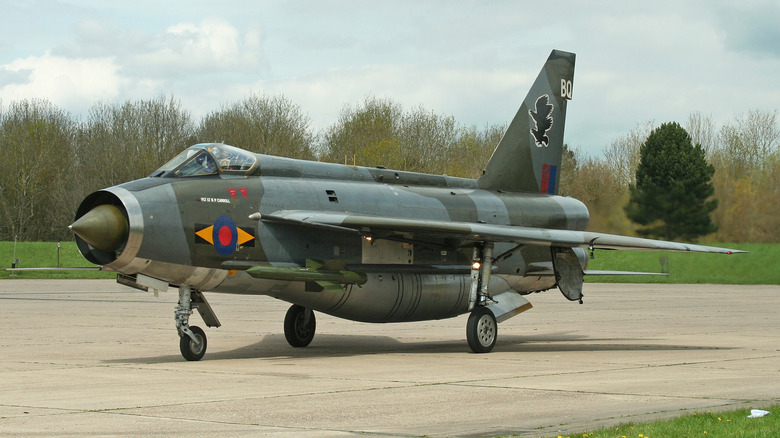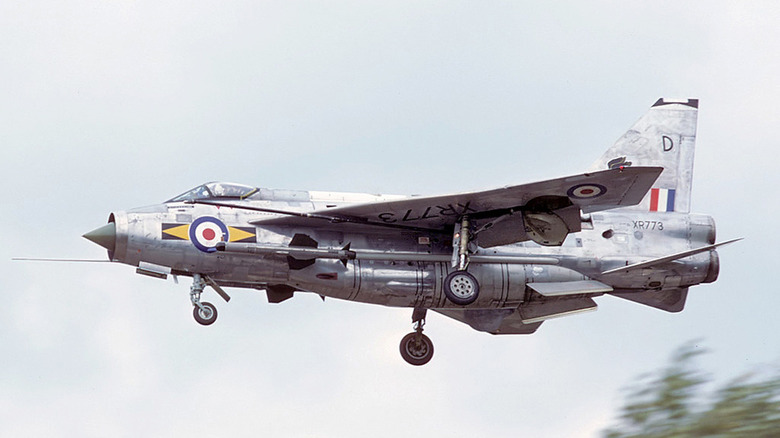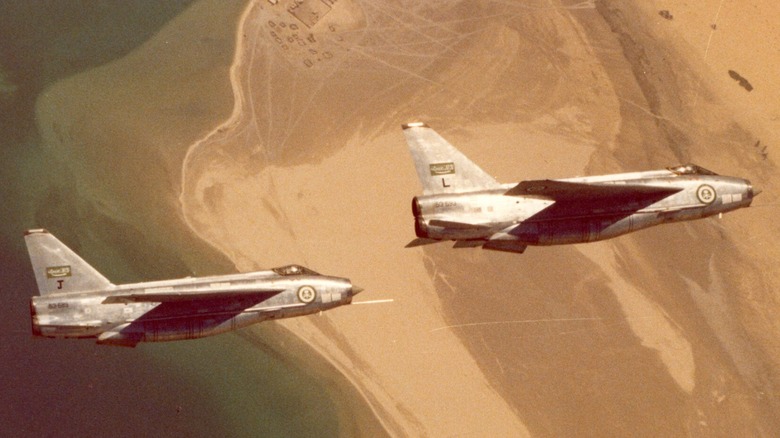
The English Electric Lightning was Britain's first supersonic jet fighter. But it was more than just a test-bed plane designed to break the sound barrier; it's also a plane with a long and storied history. The first P1B Electric flew on April 4, 1957; ironically, this was the same day the U.K. government published a white paper predicting that missiles, not manned aircraft, were the future of aerial combat. Despite this forecast, the Lightning went on to have a long and distinguished career with the Royal
Air Force, with the last planes only retiring in 1988. It says something about the quality of the plane that many pilots who made the transition from the Lightning to the more modern Tornado were less than impressed by their new aircraft.
The English Electric Lightning came out of the blocks fast, with even early prototypes breaking the sound barrier, before further developments pushed it to Mach 2 capabilities. It could even break the sound barrier when climbing vertically, thanks to its power-to-weight ratio; not too shabby for a plane that dates from the 1950s. It was developed as an interceptor, with the initial thinking that it would play the same role that the illustrious Spitfire and the somewhat underappreciated Hawker Hurricane had both fulfilled during World War 2. Let's have a closer look at Britain's first supersonic fighter, one that quickly lived up to its Lightning moniker.
Read more: 10 Largest Air Forces In The World, Ranked By Military Aircraft Numbers
The English Electric Lightning's Capabilities

Even today, the English Electric Lightning remains the only all-British supersonic fighter ever to serve with the RAF. The Lightning was a single-seat aircraft powered by two Rolls-Royce Avon turbojet engines. One startling fact about this aircraft is that despite its age, it remains one of the fastest climbing planes ever to enter military service, with a climb rate of 20,000 feet per minute. It also had an operating ceiling of 60,000 feet, but has flown as high as 80,000 feet. Yet, according to those who piloted it, it was easy to fly. English Electric's chief test pilot -- Roland Beaumont -- said it was, "very docile [and] very easy to fly" (via Imperial War Museums). Not words that are usually associated with a swept-wing, Mach-capable jet fighter.
The Electric was developed to protect the RAF's "V-Bomber" (the Victor, Vulcan, and Valiant) bases against Soviet bombing. It was also eventually used to chase high-altitude Russian spy planes, with the pilots developing a specific tactic to reach the altitudes needed to do this. This involved flying at between 35,000 and 40,000 feet until the plane reached full speed, then pulling back on the control stick and using the jet's momentum to take it to the required altitude, which would often be 60,000 feet. However, this wasn't the only role that the Lightning played. Next, we look at the history of the lightning and the role it played over its thirty years of service.
Three Decades Of Lightning Strikes

In total, there were 337 Lightnings built across 16 variants. Aside from the RAF, the Saudi Arabian and Kuwaiti air forces also used the Lightning, ultimately, leading to a 34-year service history. Maybe not as impressive as the 70-year service of the iconic B-52 Stratofortress, but impressive nevertheless, especially for a fighter jet. It was capable of carrying two air-to-air missiles (consistent across all variants), and most also featured a 30-millimeter AADEN cannon. The latter was removed on the F.3 version of the jet, much to the consternation of the pilots -- a point that saw the cannon being retrofitted to that version.
It's a testament to the original design of the plane that not much else changed over its long career. There were some changes intended to increase the jet's range by adding a new leading wing edge and additional fuel tanks. Some later versions could equip over-wing fuel tanks for ferrying purposes, and some export versions could also carry air-to-ground rockets and bombs. However, the unique appearance of the jet, with its sixty-degree swept-back wings, remained true to the original blueprints of the plane throughout its history. The English Electric Lightning may not be the oldest jet fighter still in use today, but it certainly deserves a place in the fighter jet hall of fame.
Want the latest in tech and auto trends? Subscribe to our free newsletter for the latest headlines, expert guides, and how-to tips, one email at a time.
Read the original article on SlashGear.










